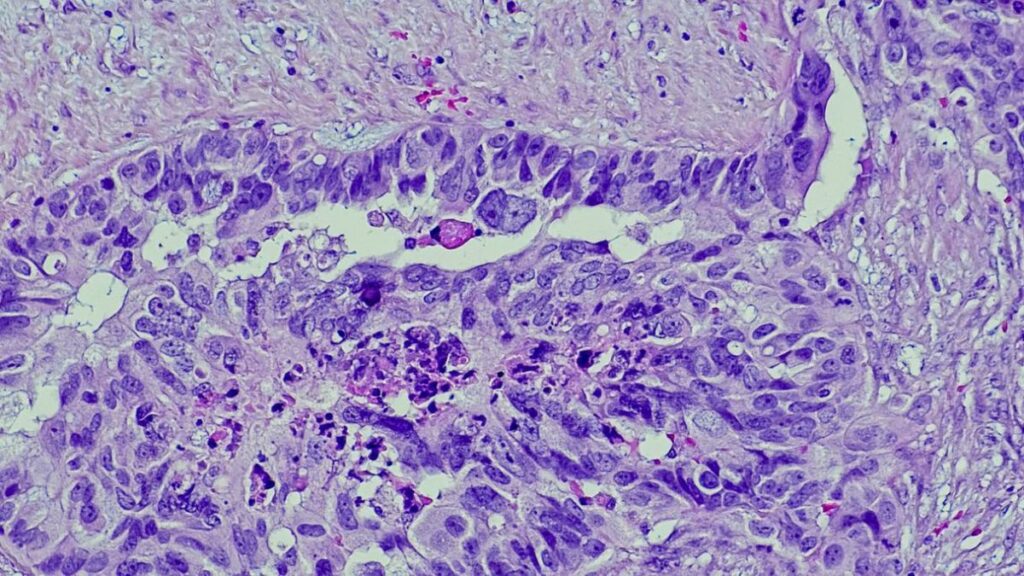A recent study conducted by University of Southern California Norris Comprehensive Cancer Center found that a blood test can identify cancerous and non-cancerous pelvic masses with high accuracy, up to 91%, outperforming other available tests.
High-grade serous ovarian carcinoma (HGSOC) is the most common and deadly type of ovarian cancer. Detecting it early is challenging because there aren’t effective screening methods when a patient has a pelvic mass or an unusual lump in the lower abdomen; determining if it’s cancerous before surgery is challenging. Unlike some other cancers, biopsies are usually not an option, making it difficult for doctors to decide the best treatment.
A groundbreaking development in the realm of medical diagnostics involves a liquid biopsy, which can identify specific nucleic acids in the bloodstream. Recent preclinical research in the Clinical Cancer Research journal indicates that this straightforward blood test might offer superior accuracy in distinguishing between benign and cancerous pelvic masses compared to current methods.
Bodour Salhia, Ph.D., co-leader of the Epigenetics Research in Cancer Program at USC Norris Comprehensive Cancer Center and the study’s corresponding author, said, “The test has the potential to improve treatment because the surgical approach to removing a pelvic mass differs depending on whether it’s benign or not. Right now, doctors essentially have to take their best guess.”
Lynda Diane Roman, MD, an associate professor of obstetrics and gynecology and gynecologic oncology division chief at the Keck School of Medicine, highlighted that having more information about the mass before surgery can help determine the right surgeon and surgical approach for the patient.

Researchers will also explore whether the new test, OvaPrintTM, can screen asymptomatic women for early-stage ovarian cancer in the general population. Detecting ovarian cancer early increases the chances of survival to over 90%. In comparison, late-stage detection reduces the opportunities to less than 40%.
Salhia, an associate professor and interim chair of the Department of Translational Genomics at the Keck School of Medicine of USC, said, “Early detection saves lives. Suppose we can accurately identify early-stage ovarian cancer. In that case, we can change the outcome of the disease and crank up survival rates.”
The OvaPrintTM test is an innovative way to find early-stage cancers. It checks for specific changes in the DNA, called methylation, by looking for modified DNA floating in the blood. Methylation can show if there’s something wrong in the body, like a disease.
OvaPrintTM is designed to catch a type of ovarian cancer called HGSOC when it’s still easy to treat. Most other ovarian cancer tests don’t do this well.
In their research, Salhia and her team focused on this specific type of ovarian cancer. They collected more than 370 samples of tissue and blood. They compared samples from patients with early-stage ovarian cancer to those with normal ovaries or non-cancerous growths.
They used advanced sequencing techniques to spot the differences in DNA between normal tissue and HGSOC tissue. These differences were related to a process called DNA methylation. They then developed a blood test to find modified DNA in the blood linked to HGSOC.
The test was tried on patients with HGSOC and those with non-cancerous ovarian masses. They used an intelligent computer system to create a tool to tell the difference between them.
To know if a test is good, researchers look at its sensitivity (how often it correctly identifies a problem) and specificity (how often it rightly says there’s no problem). OvaPrintTM is 91% accurate, meaning it’s both sensitive and specific, which is better than many other tests.
Salhia started a company, CpG Diagnostics Inc., to develop OvaPrintTM as a new way to detect ovarian cancer.
The researchers are doing another study with more patients to confirm their findings. If it works, they want to make a version of the test for doctors to use in about two years.
They’re also trying to change the test so it can find different types of ovarian cancer. Their big goal is to make a valuable test for many people, like a regular check-up.
The researchers who worked on this study include experts from the Keck School of Medicine at USC, the University of Arkansas, and Northwestern University. They received support from the Wright Foundation and Swing Against Cancer at USC Norris Comprehensive Cancer Center.
It’s worth noting that USC may get royalties from CpG Diagnostics, a company linked to this research.
USC’s groundbreaking work in developing OvaPrintTM, a liquid biopsy for early-stage ovarian cancer, holds great promise for improving the diagnosis and treatment of this deadly disease. By providing a reliable means of distinguishing cancerous from benign pelvic masses, this blood test offers hope for earlier intervention, improved patient outcomes, and a potential revolution in the early detection of ovarian cancer.
Journal reference:
- David N. Buckley, Juan Pablo Lewinger, et al., OvaPrint™ – a cell-free DNA methylation liquid biopsy for the risk assessment of high-grade serous ovarian cancer. Clinical Cancer Research. DOI: 10.1158/1078-0432.CCR-23-1197.
